Imada Puppet company [Play titles]

Imada Puppet currently performs 11 plays. Masterpieces made from the Edo era to the Meiji era, Jidaimono narrating historical heroic tales and Sewamono drawing the situations of contemporary townspeople. The bold feelings of joy, anger and sorrow reaches deep down your heart and even now it captivates the heart of the spectator. The unique original creation is Imada Puppet’s Showa play "Kotaro’s Tale" (Kotaro Monogatari). Every show is realistic, the detailed technique draws a world which touches your heartstrings.
|
"The Ceremonial Sanbaso Dance" (Kotobuki Shiki Sanbaso) |
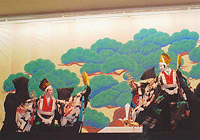 |
This dance is a celebration to pray for the tranquility and abundant crops. The "Sanbaso" danced by the Okina (old man) and Kyogen gata (comic actor) in Noh has been made into a narrative ballad, the elegance of the song verses flows until the end. After Okina and Senzai leave the stage they purified for the celebration, the two Sanbaso enters and dance to an arrangement of the following of the "Momi no dan", the second half part "Suzu no dan", this is Imada puppet’s Sanbaso. The Sanbaso starts by purifying the four corners and the five sides of the center, then dance lively to the accompaniment of wooden clappers, drum, hand drum, flute and the narration of the tayu and shamisen. Soon holding a bell, he sows a seed in the square, from that moment the dance is gradually becoming faster, tired the Sanbaso rests. The other Sanbaso forcibly makes him stand up. Lastly they dance happily together in a glorious and humorous way. ※A tayu is a reciter and singer in Bunraku puppet plays. |
|---|---|---|
|
"Ebisu dance" (Ebisu-mai) |
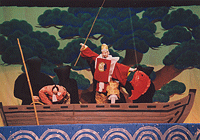 |
From the north west direction, Mr Ebisu wearing a black hat and kariginu carried a fishing pole to the head of the village’s house. The head of the village was cleaning his house and serves him god’s sake. Mr Ebisu after he drank three cups starts dancing while talking about the god of wealth... Drunk Mr Ebisu got on a boat and fished a big sea bream, all’s well that ends well, he dances. ※A kariginu is a hunting robe worn by nobles of the feudal era. |
|
"A Picture Book of the Taiko Hideyoshi" (Ehontai Kouki) 10th act Amagasaki’s act (Amagasaki no dan) |
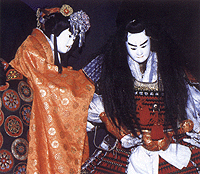 |
"A Picture Book of the Taiko Hideyoshi"(Ehontai Kouki)is the before and after tale of the protagonist of the "Honno‐ji incident", Takechi (Akechi) Mitsuhide. The 10th act of Amagasaki, called "Taiju", is the closest to the climax of the whole story. They celebrate the wedding of Mitsuhide’s only son, Jujiro, and his fiancee Hatsugiku in the Amagasaki residence of Mitsuhide’s old mother, Satsuki. A traveling monk who took one night at the inn was actually Mashiba Hisayoshi (Toyotomi Hideyoshi), intending to stab him Mitsuhide unfortunately stabbed his own mother. Jujiro came back from the first battle with serious wounds. Mitsuhide getting closer to Hisayoshi. Trying to hold Mitsuhide back Satsuki dyes with her grandson Jujiro. It is Mitsuhide’s wife Misao and Hatsugiku’s grief. Then, it is Mitsuhide and Hisayoshi’s face-to-face. This Jidaimono play is full of the real charm of Joruri leaving no time to breath. In the picture, it is the sad and pathetic scene of Hatsugiku’s “kudoki” breaking down into tears for the "suffering master Jujiro". ※A kudoki is a scene during which a female role lets out strong emotions. |
|
"The Disputed Succession of the Date Family" (Meiboku Sendai Hagi) "Masaoka’s loyalty act" (Masaoka Chuugi no dan) |
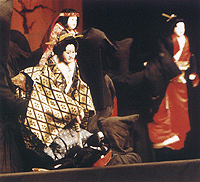 |
The tale of Oushuu’s Date clan‘s disputed succession has been performed for the first time on the 5th year of Tenmei (1785) by Edo’s Yuki troop. For certain reasons, the young Tsurukiyo succeed the head of the Date clan. A so-called conspiracy to kill Tsurukiyo in order to take over the clan was going on. Worried about a regicide Tsurukiyo’s nurse, Masaoka, made him eat only food cooked by her. The villain Yashio tried to separate Masaoka from Tsurukiyo. Using Yoritomo’s name, they brought suspicious candy at the Sakae Gozen as a gift to force Tsurukiyo to eat it. Masaoka’s child, Senmatsu, rushed in, ate it and began to suffer. To hide their crime, Yashio brutally stabs Senmatsu to death. In the picture, Senmatsu is being stabbed by Yashio. |
|
"Sugawara and the Secrets of Calligraphy" (Sugawara Denju Tenarai Kagami) "The Village School act" (Terakoya no dan) |
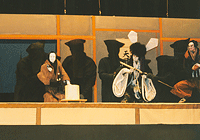 |
It is one of the three Joruri Jidaimono masterpieces. Fujiwara Tokihira who conducted Sugawara Michizane to banishment, is also going as far as to try to kill Michizane’s son, Kan Shusai. Takebe Genzo goes back to the village school to hide Shusai who was ordered to be beheaded, when he sees Kotaro who was entrusted to the school while he was away he made a big decision. There Tokihira’s servants, the investigator Genba and the identifier of the decapitated head Matsuomaru came to collect the head. The examination started. Genzo and his wife Tonami holding their breath. Genba too glaring at them with his hand on his katana. Matsuomaru and Genba leaves as it looks like Shusai’s head without a doubt. There, Kotaro’s mom Chiyo and soon Matsuomaru too, in a shinobi disguise, came back. Actually, Kotaro was Matsuomaru’s son that he entrusted as a substitute for Shusai... In the picture, it is Matsuomaru and Chiyo. |
|
"The Miracle at Tsubosaka temple" (Tsubosaka reigenki) "From Sawaichi‘s house to the shrine" (Sawaichi uchi yori otera made) |
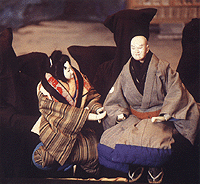 |
This is the work that Toyozawa Danpei II performed from Meiji year 20(1887) until it was corrected to this version. Close to the Tsubosaka shrine, while Sawaichi, who became blind from smallpox, is playing the koto and shamisen, he lives a small life with his wife, Osato, relying on her wage work. One day, Sawaichi who was troubled that Osato was away every night, was distracted from the shamisen. For the first time, Osato was surprised, she confided that she has been visiting Tsubosaka’s Kannon over the course of 3 years for Sawaichi’s to recover his sight. Hearing that Sawaichi apologized and went out with Osato to visit the shrine together. However, Sawaichi dived into the void while Osato was away. When Osato came to know it, she threw herself too. At this moment Kannon appears... In the picture, Osato saying "I went to see Kannon" and Sawaichi. ※Kannon is the goddess of mercy |
|
"A Tragedy of Tokushima, Act of the Pilgrim Song" (Keisei Awa no Naruto Junrei Uta no dan) |
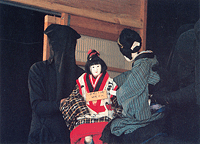 |
An adaptation of Chikamatsu Monzaemon’s original work, the series of 10 acts entangling the family tragedy was first performed on the 5th year of Showa (1930). Currently, only the 8th act "Jurobe’s House" (Jurobe Juuka) is performed. The "Act of the Pilgrim Song" is the first part of this act. Jurobe from Awa became the bandit Ginjuro living in Osaka in order to search for his master’s house treasure the Kunitsugu katana. When his wife, Oyumi, was alone taking care of the house, the young Otsuru came to visit for her "pilgrimage offering" while searching for her father and mother. Oyumi hearing her story, realized that she was her actual daughter but, rather than getting her in troubles by giving her name to Otsuru, she adjusts her hair and make her go home. However, after looking back at it, she ran after her. In the picture, hearing in Otsuru’s voice "dad’s name is Jurobe from Awa and mom’s name is Oyumi", Oyumi wants to hug her without thinking. |
|
"The Story of the Morning Glory" (Shoutsushi Asagao Banashi) From the inn to Oi river (Yadoya yori Oigawa) |
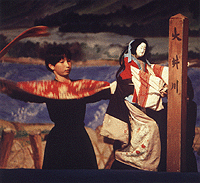 |
It is a 5-acts Jidaimono which was performed for the first time on the 3rd year of Tenpo (1833). It is the sad love tale between Miyazaki Asojiro and the old samurai daughter, Miyuki, who see each other for the first time at Uji’s firefly hunting. Komazawa Jirozaemon who took over his uncle’s house met the completely changed, blind Miyuki at the Shimada inn. However, followed by Iwashiro Takita he cannot identify himself in front of him, he entrusts an eye medicine and money to the inn owner, Ebisuya Tokuemon, and leave. Miyuki, who went down to the inn was curious for some reasons and turned back, as expected when she knew it was her lover she followed after him. There was no sight of her lover and steep heavy water blocked the crossing of the river. Miyuki with resentment towards heavens and herself, tries to throw herself into the river. But... |
|
"Oshichi’s Burning Love, Act Oshichi’s Fire Tower" (Date Musume Koi no Higanoko Oshichi hinomiyagura no dan) |
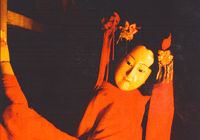 |
The series of 8-acts of the Sewamono based on Yaoya Oshichi was first performed on the 2nd year of An‘ei (1773). Now, only the 6th act "Yaoya" remains, and the "Fire Tower" part is mostly performed. Oshichi’s lover, the page Kichisaburo, hands her out a note telling her that he will have to die if he does not bring back the sword during the night. After that, Oshichi discovered that Takebee, the man she is promised to, has the sword so her servant Osugi is waiting to come take it back. The midnight bell rang closing the doors of the city. The only way to open the doors is to ring the fire bell to seem like there is a fire. Ringing the fire bell if there is no fire is punished by burning at the stake. Although, Oshichi climbs the fire tower for Kichisaburo. It was a surprise when she climbed the tower. |
|
"The Crossing at the Hidaka River" (Hidakagawa Iriai Zakura) "The ferry crossing act" (Watashiba no dan) |
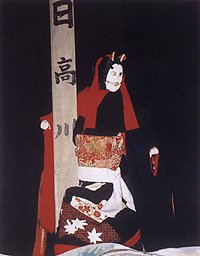 |
The legend of the Dojoji dispute over the succession to the throne of Anchin and Kiyohime entwined in a 5-acts series was first performed on the 9th year of Houreki(1759). The emperor Suzaku handed the throne over to his little brother, the prince Sakuragi, but the opposition is trying to kill him. The prince changed his name to Anchin, evaded, reached Kumano’s Manago Shoji’s house, reunited with his lover. However, Shoji’s daughter Kiyohime without knowing he was a prince fell in love with Anchin. Mad with jealousy, Kiyohime ran after Anchin. In the moonlight, Kiyohime reached the Hidaka river close to Dojoji and called the boatman but, he refused her as Anchin gave him money asking not to make her cross the river. She wanted to follow Anchin by all means and her obsession changed her into a giant snake to get accross the river. |
|
"Kotaro’s Tale" (Kotaro Monogatari) |
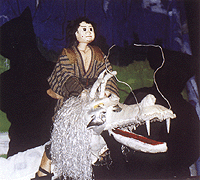 |
This original Imada Puppet work handmade by Iida’s citizen was performed for the first time on the 58th year of Showa (1983). Imada Puppet hoping to touch children who does not understand Joruri and make it enjoyable for them too, used Nagano prefecture’s folklore as a material and included regional words and songs which can be sang by children. Kotaro who turned 10 years old, with the help of his uncle the living keyaki tree and his neighbor Yuu, went out to search for his mother who was turned into a dragon because she ate from others fields to feed her baby. Kotaro met his white dragon mother at a dark lake and together they broke the mountain which released water expanding the fields. With Kotaro on her back the mother dragon soared high in the sky and he came down on earth, his mother became the heavenly dragon river and revived as a human. Finally reunited together, Kotaro and his mother lived happily in Tatsue village. |
|
"Shank’s Mare" (Tokaidochuu Hizakurige) "From Akasaka Namiki’s scene to the old shrine act" (Akasaka Namiki yori Koji no dan) |
 |
The best seller from the Edo period, Juppensha Ikku’s comic novel on the theme of "foot travelers along the Tokaido road". Yajirobe and Kitahachi living in Edo travel to Tokaido for their pilgrimage to the Ise grand shrine. The two coming out of an inn in Goyu, Mikawa province pass by a place from which it is rumored that an evil kitsune comes out. They met a dad and his child close to a graveyard and jumping to conclusions thought they were ghosts. There is also an encounter with a buddhist monk and exchanges full of humor. |

